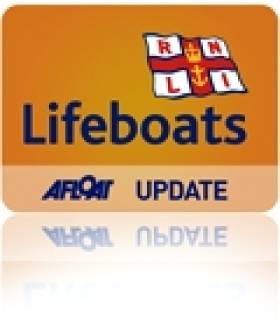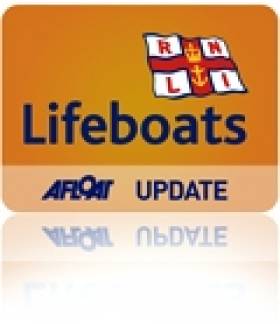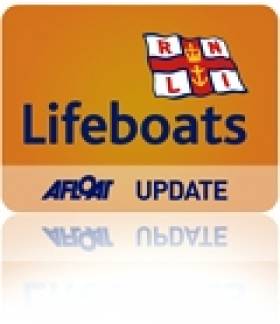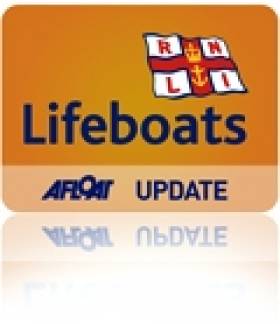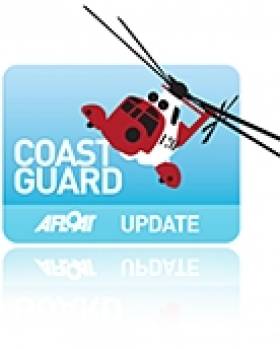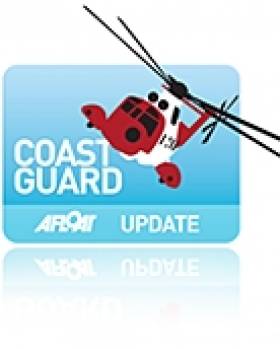Displaying items by tag: Lifeboat
Dun Laoghaire Lifeboat Saves Woman after Fall from Pier
Dun Laoghaire RNLI inshore Lifeboat Realt na Mara launched this evening at 5.02pm to rescue a woman who had fallen into the harbour close by the East Pier lighthouse.
It is believed the woman stumbled while walking along the popular pier and fell into the harbour. Her cries for help were heard by people walking on the pier, who in turn contacted the Coast guard and threw a lifebuoy into the water to keep her afloat until help arrived.
The RNLI inshore lifeboat was quickly launched and on scene in minutes. It was dark with an easterly wind blowing in the harbour. The lifeboat volunteers recovered the freezing woman from the water and brought her alongside the pier. She was then winched onboard the Coast Guard Helicopter and transferred to hospital for medical treatment.
Stephen Wynne, Dun Laoghaire RNLI Lifeboat Operations Manager said, "This is a very lucky woman. Without the quick action of the members of the public who raised the alarm and gave assistance along with the rapid response of the Dun Laoghaire RNLI volunteer lifeboat crew, we would be dealing with a tragedy today."
Related Safety posts
RNLI Lifeboats in Ireland
Safety News
Rescue News from RNLI Lifeboats in Ireland
Coast Guard News from Ireland
Water Safety News from Ireland
Marine Casualty Investigation Board News
Marine Warnings
Fenit Lifeboat Rescues Fishermen in Fog
Following a call from a fishing vessel, Fenit RNLI inshore lifeboat launched at 2pm this afternoon to go to the aid of a fishing vessel which was oyster fishing in Tralee Bay and in difficulty due to very thick fog.
Fenit RNLI inshore lifeboat under Helmsman Kevin Deady, with crew members Kevin Moriarty and Kevin Honeyman launched at 2pm and proceeded from Fenit in the direction of Blennerville. Having located the stricken vessel with 3 fishermen on board the RNLI lifeboat subsequently discovered 2 other oyster fishing boats in difficulty, each with 3 fishermen on board and completely disorientated in the heavy fog.
Fenit inshore lifeboat the Bradley and Sonya guided the 3 fishing boats back to the safety of Fenit marina where they arrived just before 3pm. Commenting on the rescue, RNLI mechanic and crew member Kevin Honeyman described the conditions as very bad with visibility down to about 10 metres. He praised the upgraded navigation system of the Bradley and Soyna which allowed them to navigate their way safely in such bad conditions and escort the fishing boats to Fenit.
Related Safety posts
RNLI Lifeboats in Ireland
Safety News
Rescue News from RNLI Lifeboats in Ireland
Coast Guard News from Ireland
Water Safety News from Ireland
Marine Casualty Investigation Board News
Marine Warnings
Lifeboat Assists Sinking Fishing Vessel in Cork Harbour
Yesterday while out on exercise in a squally southwesterly force four winds the crew of the Ballycotton lifeboat Austin Lidbury received details of a 26 foot fishing vessel that had sunk off Roches Point, at the mouth of Cork Harbour. The two crew members had taken to a liferaft and were retrieved by a fishing vessel in the area. Crosshaven lifeboat also launched and was first on scene. Ballycotton lifeboat was stood down and returned to station.
Related Safety posts
RNLI Lifeboats in Ireland
Safety News
Rescue News from RNLI Lifeboats in Ireland
Coast Guard News from Ireland
Water Safety News from Ireland
Marine Casualty Investigation Board News
Marine Warnings
Ballycotton Lifeboat Launches for Pleasure Craft in Choppy Seas
Ballycotton RNLI lifeboat was launched at 12:10 today for a pleasure craft in the Ballycotton Bay area of East Cork.
No contact had been made with the lone sailor for over an hour and his concerned family contacted the Coast Guard.
Sea conditions in the area was choppy at the time, with the wind blowing North East force 6/7.
The Ballycotton RNLI lifeboat, Austin Lidbury, were requested to launch, as were the Ballycotton Coast Guard unit and the Waterford based Coast Guard helicopter, Rescue 117.
The pleasure craft returned safely to shore under its own power shortly afterwards and the emergency units were stood down.
Related Safety posts
RNLI Lifeboats in Ireland
Safety News
Rescue News from RNLI Lifeboats in Ireland
Coast Guard News from Ireland
Water Safety News from Ireland
Marine Casualty Investigation Board News
Marine Warnings
Bangor Helmsmen Awarded Medals for Twenty Years Service
Recently two well known and respected volunteer Bangor Lifeboat helmsmen were awarded medals in recognition for their many years of devoted service to the Royal National Lifeboat Institution.
Ewan Scott and Tommy Burns have been awarded Long Service medals at recent RNLI ceremonies. During their 20 years of dedicated service, RNLI Bangor Lifeboat has undertaken a total of 845 rescues at sea resulting in the saving of 98 lives.
Both Ewan and Tommy are of one mind and agree that over the years there have been many improvements to the lifeboats, the equipment and training all of which has greatly enhanced the RNLI's ability to save life at sea.
Even after over 20 years of service Ewan and Tommy continue to freely give of their time and effort. They are considered by all to be the most experienced helmsmen at Bangor station and are actively involved in the training of crew and other volunteers.
Bangor's Lifeboat Operations Manager Kevin Byers paid tribute to Ewan and Tommy when he said 'Without the huge commitment and dedication of volunteers like Ewan and Tommy, the RNLI would be unable to carry out the increasingly demanding task of saving lives at sea.' Kevin went on to say 'I am delighted that Ewan and Tommy have been presented with these awards, they deserve a big thank you for all they have done for Bangor Lifeboat over the past 20 years.'

Related Safety posts
RNLI Lifeboats in Ireland
Safety News
Rescue News from RNLI Lifeboats in Ireland
Coast Guard News from Ireland
Water Safety News from Ireland
Marine Casualty Investigation Board News
Marine Warnings
Family Say 'Thank You' to Portrush Lifeboat for Saving Son
A grateful family presented a cheque to Portrush lifeboat crew in thanks for saving their son this summer.
On 16th May 2010 both Portrush Lifeboats were launched to two separate incidents within one at 0922 hours and one at 0924 hours.
Within minutes two full volunteer crews had assembled and both the All-weather Lifeboat and the Inshore Lifeboat were launched. The Inshore Lifeboat was launched to reports of two young people in the water at Dhu Varren. Karl O'Neill was at the helm supported by Nick Christie and Jonathan Weston. Two youths had gone into the sea after a dog, and were starting to experience real difficulties in getting back to shore. One of the youths Damian Morris had sustained cuts to his arms and legs, was suffering hypothermia and was literally going under the water for the third time when the Portrush Lifeboat arrived on scene. Damian spent several days in hospital as a result of the incident and was delighted to be able to come to the station to meet the crew who had saved him that day.
Damian's uncle and Godfather Raymond Comac and his friend Paul McGuigan, do a lot of charity work in Damian's hometown in Omagh holding fundraisers to raise funds to take motorbikes out to South Africa for use by health care workers in the townships. However this year, they divided the proceeds between their charity and the RNLI, in recognition of the fact that the volunteer crew at Portrush had saved Damian's life.
Damian's parents Liam and Rosemary Morris, Damian himself and his uncle Raymond and friend Paul travelled to Portrush to meet the crew and hand over a cheque for £1000. Both Nick and Karl were overwhelmed by the generosity and stated;
'We don't do this for thanks, but it's so nice to meet someone that you have helped and for this amount to be raised is fantastic for the station'
The family got a tour of the station and had a look at the new Inshore lifeboat 'The David Roulston' which took over from the 'Ken and Mary' the boat that responded to the call that day....one of her last launches.

Related Safety posts
RNLI Lifeboats in Ireland
Safety News
Rescue News from RNLI Lifeboats in Ireland
Coast Guard News from Ireland
Water Safety News from Ireland
Marine Casualty Investigation Board News
Marine Warnings
Woman Airlifted to Cliff Top
The woman who is not local to the area was walking with her 10 and 17 year old sons and had climbed some rocks near the caravan park but had become stuck. The children had managed to scramble to the top of the cliffs and raise the alarm. They were unable to help their mother.
The weather this afternoon has been south westerly winds force 5 – 7 with occasional rain with low visibility.
The Tenby Coastguard Rescue Team which has a cliff capability, and Tenby RNLI all weather lifeboat with its 'Y' boat was asked to turn out, and the Coastguard Sector Manager for Pembroke also attended. The RNLI inshore lifeboat was also launched.
Due to the prevailing weather and surf conditions a rescue helicopter – Rescue 169 - from RAF Chivenor was also scrambled.
Bob Peel, Coastguard Watch manager at Milford haven Coastguard said
"Once the woman's location had been determined and a Coastguard lowered to her on the rocks it was agreed amongst all the rescuing parties that with the 2 lifeboat crewmen and 1 cliff man from the Coastguard with the woman, it was probably too dangerous to evacuate everyone by boat.
"There is dense gorse and blackthorn at the top of the cliff is and it would have proved difficult to recover her safely for the cliff team, so the rescue helicopter was requested. By 4.00 pm the helicopter crew were winching the female and Coastguard up from the base of the cliff whilst the two crewmen returned to the all weather lifeboat by their Y boat. The woman was cold and shaken and had no need of medical attention.
"This is a salutary lesson in making sure that if you are in unknown terrain without the suitable climbing gear please don't attempt slippery cliff and rock faces, as inevitably rocky terrain can catch the unprepared out very quickly."
Special Plaque Remembers Portrush Lifeboat Tragedy
The three volunteer crew men who lost their lives were James McAlister, a local fisherman, William McNeill and Galbraith Hamilton Grills, the Chief Officer of the Coastguard at Portrush.
To-day on the anniversary of that tragic night, William McNeill's great grandson Ronald Handy and his wife Lily presented the Station with a plaque in memory of the three crew men who lost their lives on that November night in 1889.
On an interesting note, Tracey McAlister the great great granddaughter of James McAlister is presently the press officer for Portrush Fundraising team, thus continuing the family links with the Lifeboat.
Lifeboat Rescues Two Fishermen After Ten Hours Stranded in Liferaft
Two young fishermen are recovering today (Sunday 31 October 2010) after being rescued by lifeboat crew from Ballyglass RNLI. The two men were found in a liferaft 13 miles north of Belderrig in County Mayo after a lifeboat crewmember raised the alarm when they had not returned after to shore last night. Their fishing vessel had capsized and unable to raise the alarm the two men spent ten hours at sea in a liferaft waiting for help.
Ballyglass RNLI volunteer crewmember John Walsh contacted the Ballyglass Lifeboat Operations Manager when a fishing vessel had not returned to Porturlin when expected. Lifeboat Operations Manager Harry McCallum got in touch with Malin Head Coast Guard and the Ballyglass RNLI all weather lifeboat was launched at 11.49pm along with the Sligo based Coast Guard helicopter.
The rescue crews headed to the area where the fishermen were understood to be recovering pots from the water. The helicopter crew spotted the liferaft with the two men onboard and communicated the position to the lifeboat, which was nearby. The men had managed to remove their wet clothes and had put on plastic sacks to keep warm. They were recovered onto the lifeboat and taken to Ballyglass to recover.
Commenting on the callout Ballyglass RNLI Coxswain JT Gaughran said, " These two young men were extremely lucky. There had been nobody out searching for them until our crewmember John Walsh, who is an experienced fisherman, raised the alarm. Things can go wrong very quickly out at sea and every second counts. Thankfully conditions were moderate and once the search was underway they were spotted quickly."
The lifeboat pictured below returned to Ballyglass at 3am this morning with the two men onboard.
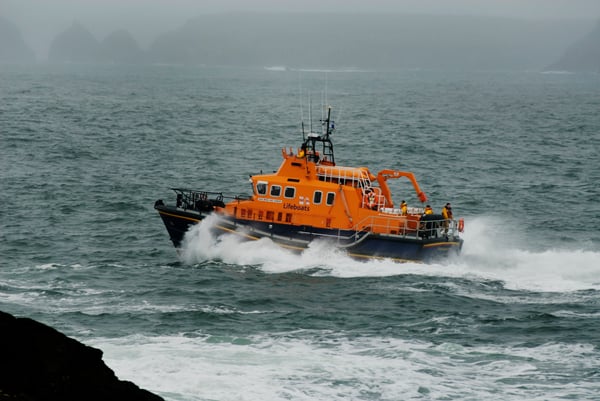
Related Safety posts
RNLI Lifeboats in Ireland
Safety News
Rescue News from RNLI Lifeboats in Ireland
Coast Guard News from Ireland
Water Safety News from Ireland
Marine Casualty Investigation Board News
Marine Warnings
Woman Airlifted From Beach After Fall
The woman who was staying at Manorbier, had fallen near to a cave and was now on rocks to the west of the beach. Her young son (aged 11) was with her at the time along with another youngster, aged 14. The tide was coming in and there was no access out of the area, which allowed her evacuation from the area only by sea. Another member of the public who had witnessed the accident called the Coastguard for assistance.
The Tenby Coastguard Rescue Team were immediately turned out and the RNLI Tenby All weather Lifeboat with their 'Y' boat on board was also asked to launch. A rescue helicopter from RAF Chivenor was also scrambled given the inaccessibility of the area.
The weather on scene late this afternoon was southwesterly winds force 5 to 7 with moderate seas and squally showers.
From reports at the beach it was decided that conditions were too rough to effect either a cliff rescue or sea evacuation and the rescue helicopter landed on the beach and administered first aid to the woman who was in acute pain. It then took all three people off to Withybush hospital.
Nigel Yelland, Watch manager at Milford Haven Coastguard said
"The area in which the woman was exploring can be quite challenging in wet weather, and rocks can become very slippery underfoot. We're advising that as the autumnal weather becomes more hostile please wear the most appropriate clothing and footwear for the coastal areas you intend to walk, and make sure you have some method of communication to the outside world."




























